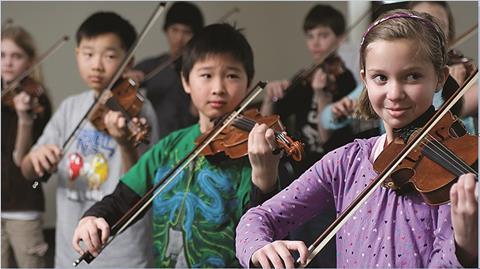Sound quality should be the main focus of string teaching
Sound quality should be the main focus of string teaching
Young students improve when they learn to listen to themselves, says Royal Northern College of Music senior lecturer in music education Philippa Bunting

At the American String Teachers Association’s recent conference, I heard an insight of pure gold during Kurt Sassmannshaus’s masterclass on Bach’s C major Fugue. In its simplicity, it seemed to sum up a fundamental truth about this wonderful enterprise of ours.
Concert-goers, he argued, can expect a certain ‘professional minimum’: the notes will all be in tune and in the right place. Beyond that, ‘It’s the quality of the sound that brings the audience back.’
Of course. Isn’t that the whole point? And yet, do we always keep the sound at the forefront of our teaching, and encourage the development of the individual voice? Are we not sometimes guilty of pursuing a technical point on a ‘because I say so’ basis, with no reference to the demonstrable improvement in the sound? That is, after all, the only true motivation for technical change. Put simply, if it doesn’t sound any better, why do it?
We all know pupils who, despite having the sort of quirky physical habits that cause us to wake up screaming, nevertheless produce a wonderful sound. Mercifully for our sleep patterns, they are in the minority. The rest conform to the common laws of physics that state that tension in the body results in a tense, weedy sound. And what about the technician who can produce streams of utterly accurate musical gestures, impressive but almost entirely bereft of meaning? Or the child who oozes music with every movement, but has no technical discipline to enable that expression to reach its audience?
It’s the continuation of an age-old debate. Does the technique have to be impeccable before any music at all can be realised, or is it possible for something imperfect to say something valuable? The classical establishment has always tended to promulgate the former view, perhaps rightly given the rigours of a professional career, but could it be that the truth lies elsewhere?
If we put sound at the heart of what we do, it suddenly makes sense. We can focus on quality right from the beginning and invite our pupils to hone their individual voice, giving them a reason to improve.
Music can’t be either right or wrong. It’s something that, as well as being meaningful, is either beautiful or not. And you and I, as audiences or teachers, are likely to have completely different views on what constitutes that beauty. The ultimate arbiters, though, are the players themselves. When we decide to go to a concert, are we not often choosing to hear an individual soloist? The repertoire is important, of course, but we trust the person we’ve paid to hear to lead us through it. We must want to hear their particular sound.
For young children, the tone produced on the instrument usually has a direct relation to the singing voice. Even if they aren’t yet ready to analyse and then negotiate soundpoints, or complex relationships between arm weight and bow speed, they can be encouraged to sing through their instruments. They can start to think about where they are, who they might be playing to, how they feel about the piece and what it means.
The most beautiful rendition of Twinkle, Twinkle Little Star I’ve heard came from a young pupil who said he could imagine playing it inside his tent, looking out to see the moon and stars above, hearing the voices of his parents nearby, talking around a campfire as they prepared supper. I have no idea whether it was a real memory, a wish or a story manufactured for the occasion, but the sound was unbelievable – intense, wistful and pure. I can remember it to this day. In a couple of decades’ time, if he’s managed to preserve that instinct for sound I’ll be camping out for tickets.
I’ve just spent a week working with a group of kids aged nine to eleven. When it came to the concert, they produced some really exciting colours and variations in dynamics. The simple reason was that in addition to thinking hard about the sound we wanted, and why, we worked from silence every time. Creating that moment of poise, and inviting thechildren to listen to themselves properly, made a dramatic impact on the quality of what we produced together. They sounded good and they knew it.
Thomas Beecham is frequently quoted as saying: ‘The English may not like music, but they absolutely love the noise it makes.’ Whether that is true of the little islanders or not, ‘the noise it makes’ is surely the most important thing about it.
This article was originally published in The Strad's June 2012 issue.


.png?width=265&quality=100&cache=always&mode=crop&iefix=true&speed=2)